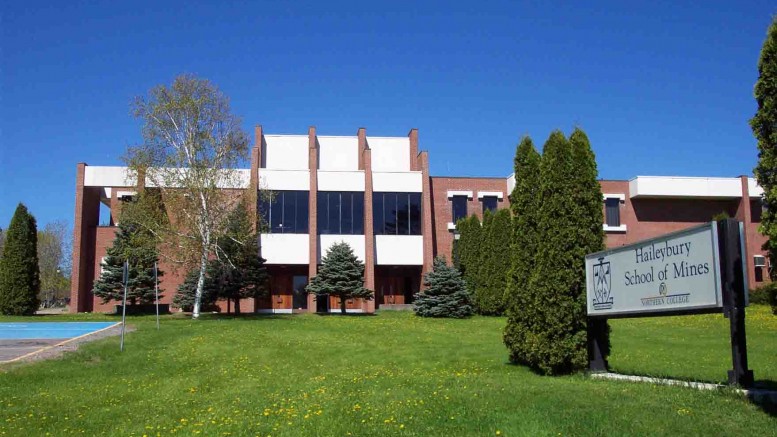More than 200 alumni, faculty and friends gathered for a June weekend to celebrate the one-hundredth anniversary of the Haileybury School of Mines (HSM), including luminaries such as Mining Technologies International president and CEO Bob Lipic, Redpath president and CEO George Flumerfelt and Bogart Leslie, a former assayer at Lakeshore Gold mines in Kirkland Lake who recently celebrated his 102nd birthday.
As alumni from as far afield as Norway and Chile rekindled old bonds, “there was a lot of hugging, kissing and crying,” says Brian Dobbs, a professor of instrumentation at the Haileybury campus of Northern College and president of the HSM alumni association.
The well-attended and emotional gathering is testament to the impact HSM has had on the mining industry in Canada and abroad. Established in 1912 to supply the growing silver camp in nearby Cobalt with mining and milling expertise, the college grew to boast enrollments of up to 200 in the 1960s, when there was a pressing need for its graduates to operate new mines springing up in Elliot Lake, Sudbury and across the nation.
The school was unique because it had its own mill, state-of-the-art metallurgical equipment supplied by the industry and courses ranging from drafting to assaying. “When graduates finished they could go into any aspect of mining because they were trained in most of them,” Dobbs says. “They were hands-on and ready to jump into the industry.”
Several mining pioneers called HSM their alma mater, including William Durrell, general manager of the Iron Ore Company of Canada; Alex Mosher, a successful prospector and one of the founders of the Prospectors and Developers Association of Canada; and Murray Watts, one of the founders of consulting firm Watts, Griffis and McOuat that, coincidentally, is celebrating its fiftieth anniversary this year.
While the first crops of HSM graduates were snapped up by the hundred-plus mines that developed as a result of the Cobalt silver rush, the school hit some rough patches later when both world wars robbed it of students. In 1944 the Ontario government acquired the school when it was no longer able to sustain a viable enrollment.
HSM found new life as a public vocational training school, attracting 42 students — including 26 war veterans — in its first year of operation under the leadership of Ossian “Ossie” Walli, the former vice-principal of Timmins High and Vocational School. Walli retired a quarter of a century later, in 1969, and was inducted into the Canadian Mining Hall of Fame in 1993 for his contributions to mining education.
One intriguing role the school played was as a training ground for mine operators in Africa, mostly from the Williamson diamond mine in Tanzania. The mine’s founder, Canadian Mining of Hall of Fame member John Williamson, was a strong believer in global education. During the 1960s he recruited several geologists from his alma mater, McGill University, to work with him in Tanzania. In return, he sent Tanzanians to Haileybury to learn how to run mines.
Students from Nigeria, Uganda and South Africa followed, transforming HSM into a truly international mining school. As a child, Dobbs was astounded by the sight of Africans walking around the predominantly white northern Ontario town, and he estimates that about a quarter of the student population hailed from Africa during that era.
HSM went on to help establish mining schools in Zimbabwe and Chile, and it has taken the lead on several international mining education and training projects.
But Walli’s dream of transforming HSM into a centre of Canadian mining research was dashed when the Ontario government decided to incorporate HSM into the province-wide community college system. In 1966 a new college, Northern College, was formed that amalgamated HSM with other technical programs in northern Ontario. The Haileybury campus was awarded $3.5 million in funding to expand its facilities and introduce instrumentation as a specialty program.
Walli spent two years as Northern College’s first president before retiring. Long-time faculty member John Frey, who led the school for the next 22 years until his retirement in 1989, succeeded him as dean of HSM.
In the 1990s, HSM suffered declining enrolment. To remain viable, the Haileybury campus introduced new programs including veterinary technician training that today attract most of the student population.
Of the remaining mining students, the majority attain a two-year diploma through long-distance, online courses, Dobbs says. Most work full-time in the industry and pursue their studies on a part-time basis. They come together only once, for a two-week summer field camp operated out of Haileybury that teaches them geological mapping, surveying and milling.
As part of the one-hundredth year celebrations, HSM has unveiled a legacy project in the main foyer that includes a showcase of the school’s history and a display of the Alumni Hall of Fame. Five new members were inducted into the hall this year to bring the total to 28.
— Virginia Heffernan is a freelance writer specializing in mining issues, and is principal of Toronto-based GeoPen Communications at www.geopen.com.


Be the first to comment on "Haileybury School of Mines celebrates centenary"